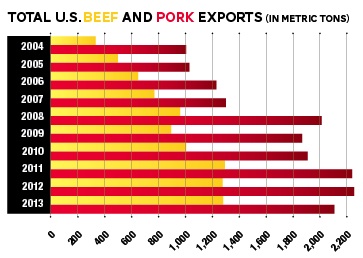Global meat consumption is still ascending. Its expected growth is pegged at about 1.9% per year from 2014-2023. Meat shipments from major exporters are projected to rise 2.2% per year.
“With the tight domestic supply and emerging explosion of global trade, it’s absolutely the most dynamic landscape I’ve ever seen,” says Don Close, protein analyst for Rabobank Food and Agribusiness Research and Advisory Group.
About 14% of U.S. beef is exported. Exports added $245 per head to the value of a beef carcass in 2013 and $54 a head for a hog carcass, based on U.S. Meat Export Federation data. (This includes muscle cut and variety meat values).
Midsummer beef exports fell but were still 4% higher in volume and steady in value.
Hong Kong, the fourth largest market for U.S. beef and beef product exports, reopened to the U.S. in mid-June. Sales hit a historic $823 million in 2013. Prior to this agreement, only deboned U.S. beef could be shipped. Mexico, Uruguay, Ecuador, and Sri Lanka also lifted their longtime restrictions.
Rabobank’s third-quarter global beef report indicates a relatively balanced supply/demand market. It forecasts strong price levels based on limited supply, strong import demand, and high prices for competing proteins.
Demand for U.S. beef in Asia is building. Imports of grain-fed beef by higher-income countries are projected to grow steadily. U.S. exports to these countries are expected to rise after 2014.
“In countries with limited resources, it makes more sense to import meat than to import grain for their livestock,” says Howard Hill, president of National Pork Producers Council.

However, availability of feeder cattle and rising production costs will limit production expansion across the globe into 2015.
In the decade since the Central American Free Trade Agreement-Dominican Republic (CAFTA-DR), Honduras has become a top 10 destination for U.S. pork. Guatemala also is a strong importer of beef and pork.
In Central and South America, Colombia is the largest destination for U.S. pork. Chile is a top 10 market for U.S. beef and pork. Peru ranks at number 15 for beef. Last year, U.S. beef exports totaled 17,352 metric tons, valued at $32.8 million. It’s the eighth-largest volume destination for U.S. beef and the 13th largest in export value.
U.S. pork also is gaining traction in Peru. Last year, exports more than doubled from 2012, reaching 2,279 metric tons valued at $5.6 million.
“Today, we export 25% of all U.S. pork production,” Hill says. “That includes muscle and variety, offal, organ, ears, and snouts. One fourth is variety meat. The U.S. has a low-cost, high-quality product that’s attractive globally. Asia, Southeast Asia, and China have tremendous growth potential.
“Pork exports over the next few years will be in countries with young, growing populations and economies, and middle class incomes, especially Asia, Southeast China, and Africa,” he says.
Dairy ExportsBetween China pulling back on purchases of dairy products for at least the next six months and the Russian import ban, U.S. dairy prices will depend on the appetite in regions like Southeast Asia.
The main driver behind slowed demand and lower prices is dairy fundamentals, says Tim Hunt, global dairy strategist, Rabobank Food and Agribusiness Research and Advisory Group.
“The long-term story looks better,” he says. “Population growth, rising income, and urbanization mean the world’s milk producers will struggle to keep up with demand due to rising production costs.”
Source:
http://www.agriculture.com/news/livestock/increasing-global-appetite-f-protein_3-ar45905





